The Tomb from Tigrane Pasha Street
The Main Tomb at Kom el-Shoqafa( the Tigrane Tomb) presents the most convincing case for active worship of Isis and her mysteries in Alexandria.
In comparison to the scale of the Great Catacomb at Kom el-Shoqafa, the Tigrane Tomb, which was discovered in 1952 in the eastern necropolis near the tombs at Moustapha Pasha, appears exceedingly modest.
it consisted of one room fitted with loculi and another in the form of a triclinium-shaped burial chamber, but only the burial chamber was removed from the earth. The triclinium shapeA triclinium (plural: triclinia) is a formal dining room in a Roman building. The word is adopted from the Greek triklinion (τρικλίνιον)—from tri- (τρι-), "three", and klinē (κλίνη), a sort of couch or rather chaise longue. of the burial chamber is formed, as it is in the Main Tomb at Kom el-Shoqafa and other Roman-period tombs in Alexandria, by the arrangement of three niches – in its case arcosolia The word is from Latin arcus, "arch", and solium, "throne" (literally: "place of state") or post-classical "sarcophagus".– created by the sarcophagi carved from the living rock.
the designer, though lacking Egyptian content for the scenes he was commissioned to create, intended to replicate Egyptian style in order to ensure an Egyptian guise for the narratives.
The Tigrane burial room is covered by a shallow dome , and it is the painted dome that provides the approximate date of the tomb. It is well known that the emperor Hadrian, who ruled from 117 to 138 ce, was enamored with domes, employing in his monuments myriad variations on the theme. Thereafter, Hadrianic domes inspired painted ceilings in Rome and throughout the empire,and the one in the Tigrane Tomb marks one of the most successful examples of the conceit. It is most likely, then, that the Tigrane Tomb dates either within, or slightly after, the Hadrianic period, probably somewhat later than the Main Tomb at Kom el-Shoqafa.
In another Classical reference, an image of a gorgoneion peers through the painted oculus of the Tigrane dome, protecting the tomb from above. Concurrently, egyptianizing images on the lateral walls and the inner pilasters of the niches – seated figures of cynocephalus Anubis, Horus falcons wearing crowns of Upper or Lower Egypt, recumbent sphinxes with nemes headdresses, and snakes including cobras – secure the bodies interred in the sarcophagi they guard. Snakes, too, rear up on the short walls of the burial chamber that flank the doorway, protecting the tomb as they do on the exterior wall of the burial chamber in the Main Tomb at Kom el-Shoqafa. Thus the inviolability of each burial niche in the Tigrane Tomb is preserved, as is the entire interior space of the room.
The snakes on the entrance wall are also identified with the cult of Isis. A poorly realized crown formed of sun-disc and horns identifies the left snake as Isis-Thermouthis (the Egyptian grain goddess, who frequently assumed the form of an asp or a cobra), though in the Tigrane Tomb other attributes often associated with the Graeco-Roman iconography for this deity are lacking. The right snake is characterized by its pschent crown and beard as Serapis (or the Agathos Daimon, the consort of Isis-Thermouthis or of Isis in her role as Agatha Tyche) although it too lacks further attributes.

On the short walls that lead to the burial chamber, two male figures, each placed in a panel under an image of an Apis bull, escort the visitor into the room. Garbed in kilts and corsets, they add the pharaoh's nemes headdress and, beneath their chins, very narrow lines indicate they also wear the false beard of a pharaoh . Whether the ‘pharaoh’ figures in the Main Tomb at Kom el-Shoqafa are indeed emperors or just meant to recall regality, the figures in the much smaller Tigrane Tomb shed any connection with an emperor. Rather they represent an ‘Egyptian figure’ coupled with intimations of royalty, which is reemphasized by the images of the Apis bulls above them. Each male figure carries a situla in his lowered hand, and it is probable that these vessels are meant to mark the deceased patrons as adherents to the initiatory cult of Isis.
Alexandria, the Tigrane Tomb, the Male Figure in the Entrance Corridor to the Burial Room
This interpretation is borne out in the decoration of the three arcosolia. The central niche shows a mummy flanked by female figures – intended surely as Isis and Nephthys – who hold palm branches in their hands and by Horus falcons supported by alabaster stands . Whether the female figures are intended as epiphanies of the goddesses or as priestess avatars for the goddesses is difficult to determine (and perhaps any distinction is inconsequential), but I now prefer the latter interpretation. please note that the wings the right-hand female figure wears seem rather to be part of a costume than the wings of deities, and both females act within a space set back from the podiums that support the Horus falcons as if on a stage. The scene appears as a performance.
Alexandria, the Tigrane Tomb, the Central Niche
A winged disc hovers overhead extending a Roman-styled garland in its claws. The configuration recalls both the winged discs that have traditionally terminated Egyptian stelae and Greek and Roman funerary garlands. Yet whether the garland is meant to evoke the offering of funerary garlands – as is seen in Greek imagery and in the tomb of Petosiris at Tuna el-Gebel – or just the display of garlands – as in the real garlands and the painted simulacra in Alexandrian tombs – is difficult to discern, though I think the latter interpretation is probably the more likely.
The Tigrane scene certainly references the canonical image of the death of Osiris, but I do not think that the mummy is meant to be Osiris. The Tigrane mummy is wrapped in contemporaneous Roman-period reticulated bandaging, and it lies not on the traditional lion-bed but on a contemporaneous kline with a duck-headed fulcrum and turned legs that cast shadows on the intentionally ill-defined ground.
The cloth on the bier is treated with fine lines to indicate the folds into which it falls, and the plinths of the stands that support the falcons are treated in one-point perspective. The cast shadows, the treatment of the looping folds of the bier-cloth, the disposition of the figures in space by the rejection of a single groundline, and the perspectival treatment of the bases of the stands that support the Horus falcons are intentional, as their absence from the scenes in the other two arcosolia demonstrates, and these details place this image of the deceased in the quotidian world. These elements both remove the mummy from representing Osiris and permit this image to act similarly to those of the Hellenically drawn images of the deceased in tombs of the chora, , that also differentiate the mundane realm from the metaphysical.
The lateral niches support the interpretation of the mummy in the central niche as representing a deceased human male and also support the interpretation of the males in the entrance way as devotees in the cult of Isis. Unlike the central niche, however, which is easily read because of its reliance on Egyptian iconographical prototypes, the lateral niches find no parallel in either Egyptian or Classical representation.
The left niche shows a frontal male holding palm branches and flanked by winged, nemes-headdressed, trousered males to either side, as another disc spreads its wings above the group . Two jackals sit attentively at the frontal male's feet, and the entire scene is closed off by colonnettes that carry large, oval, beribboned objects that Adriani thought were tympana, but that I take as greatly oversized eggs. Like the mummy in the central niche and like the figure in the right niche that is discussed later, the frontal figure wears a garment with a reticulated pattern, as an initiate having gone through the simulated death –
his mummy wrappings falling away as he emerges nude to assume apparel fitting his new status. He, like the two ‘goddesses’ in the central niche, holds palm branches, which are connected directly with the cult of Isis. It is most probable that in cultic monuments, as with, for example, a triumphant athlete in a mosaic from the Baths of Caracalla now in the Vatican, these branches speak to victory, but in the case of the initiate, it is the victory over death (see Apuleius, Metamorphoses, XI.21; 283.8–9).
Alexandria, the Tigrane Tomb, the Left Niche
The right niche completes the narrative. A young man wearing garb similar to the frontal male in the left niche – but more complete – extends palm branches to the standing goddess (or priestess stand-in) who, in turn, offers him sheaves of golden grain, while a figure with a censor follows him . With his leggings, his imbricated tunic, and his nemes headcloth, the kneeling male figure resembles the flanking males from the left niche, although he lacks their wings. The niches convey a narrative contending that the frontal male in the left niche, having passed through the rigor of the ordeal, has – in the right niche – become an initiate and has assumed his new garments, replicating those of the males in the left niche.


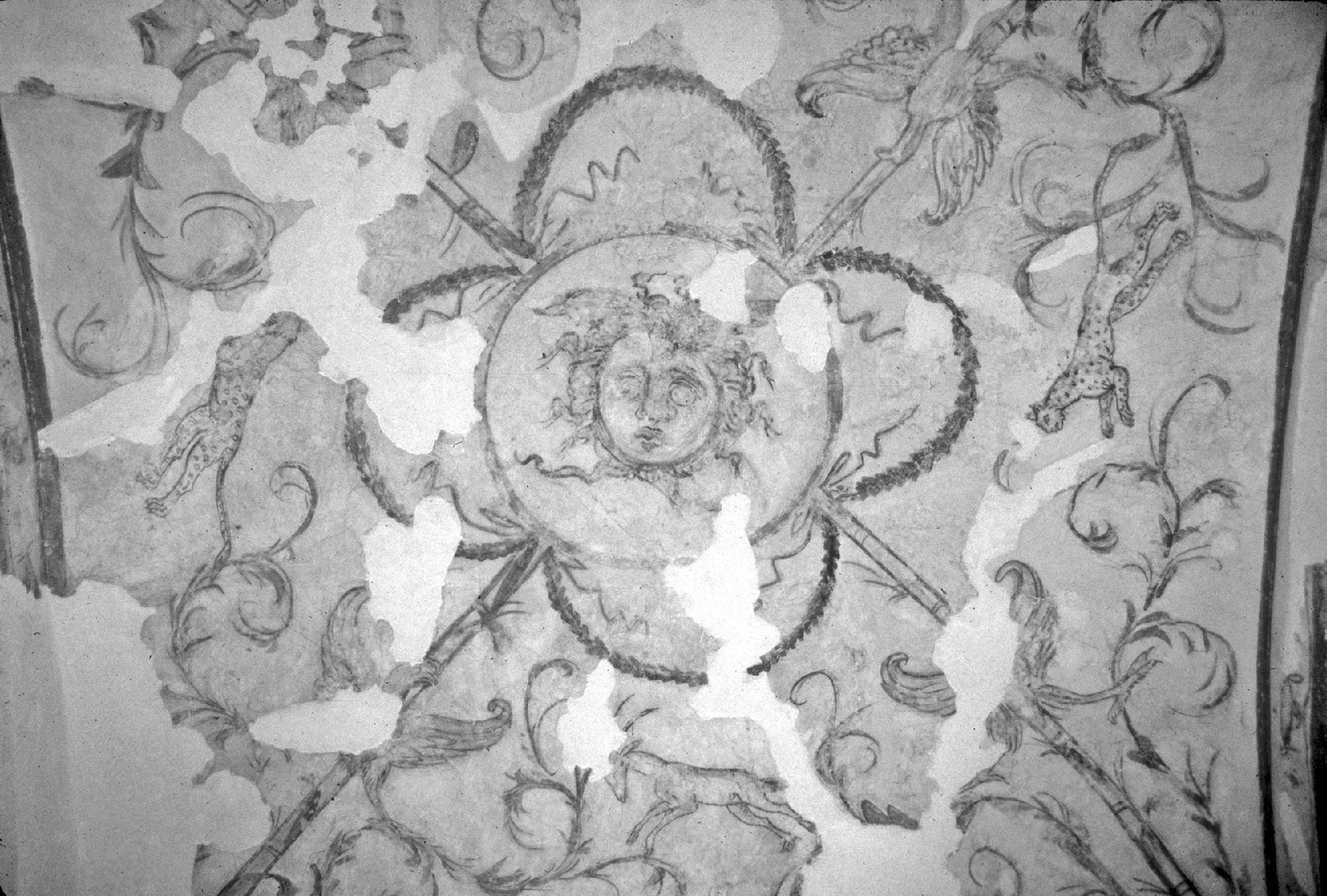
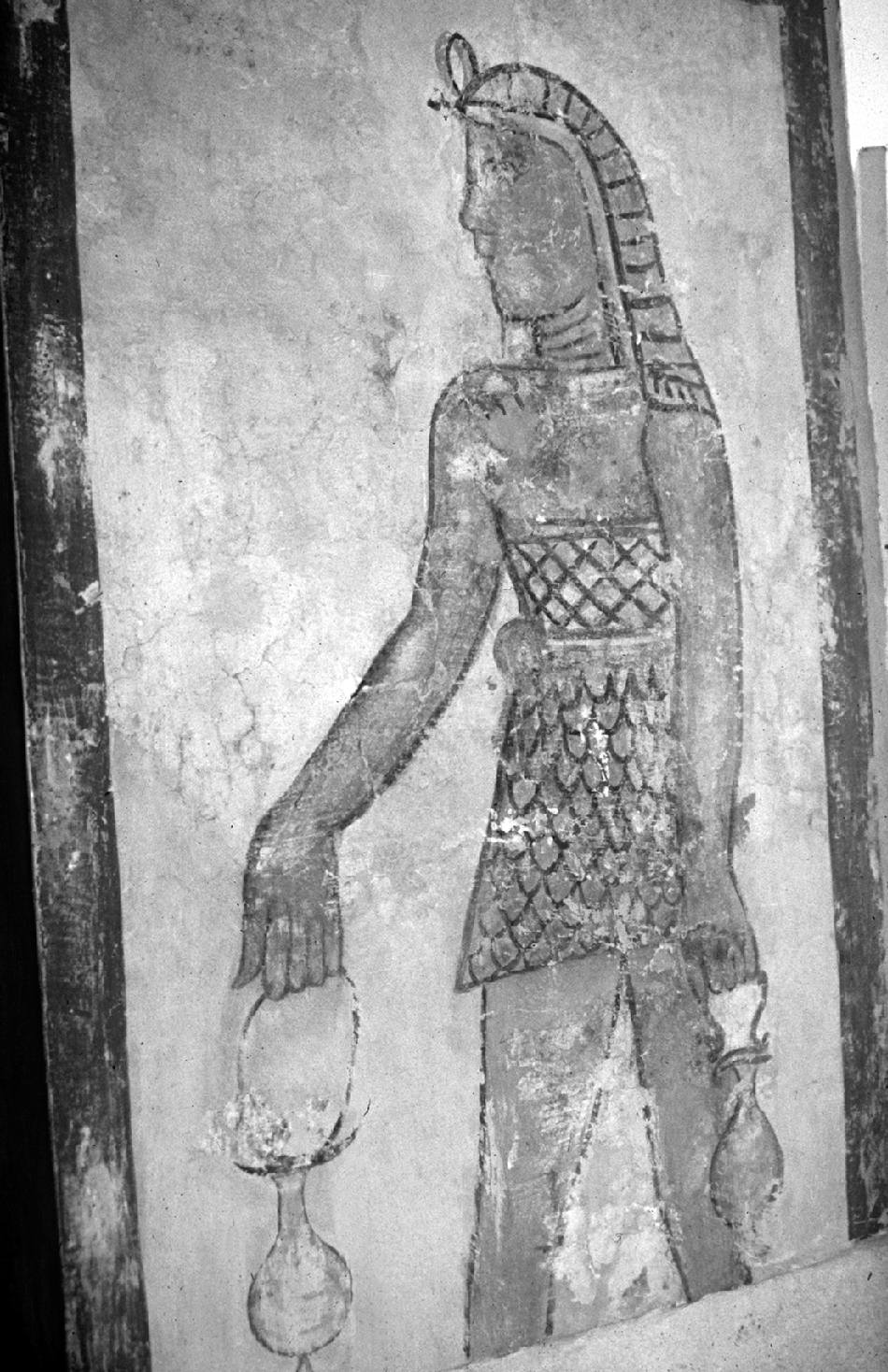
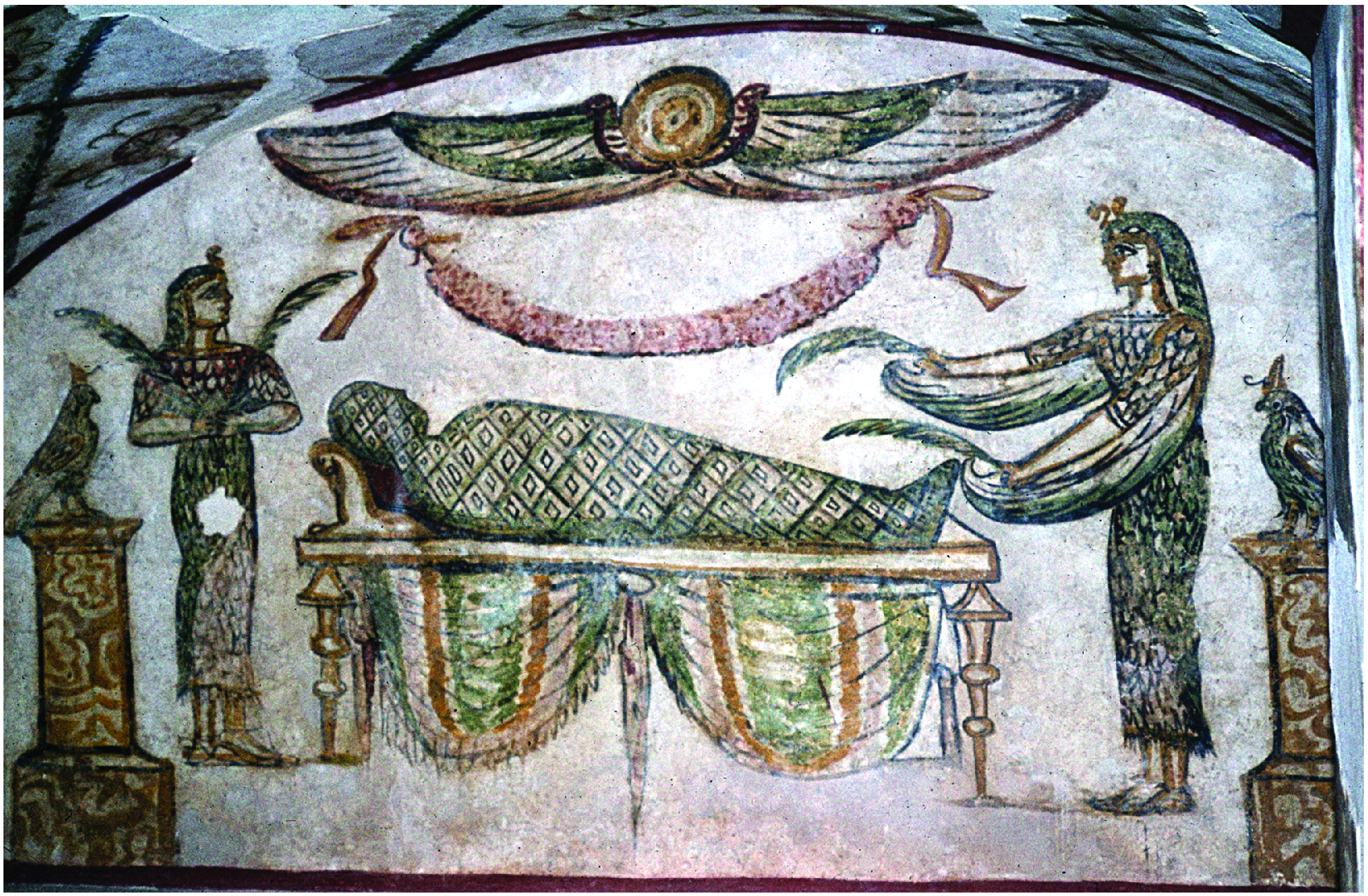

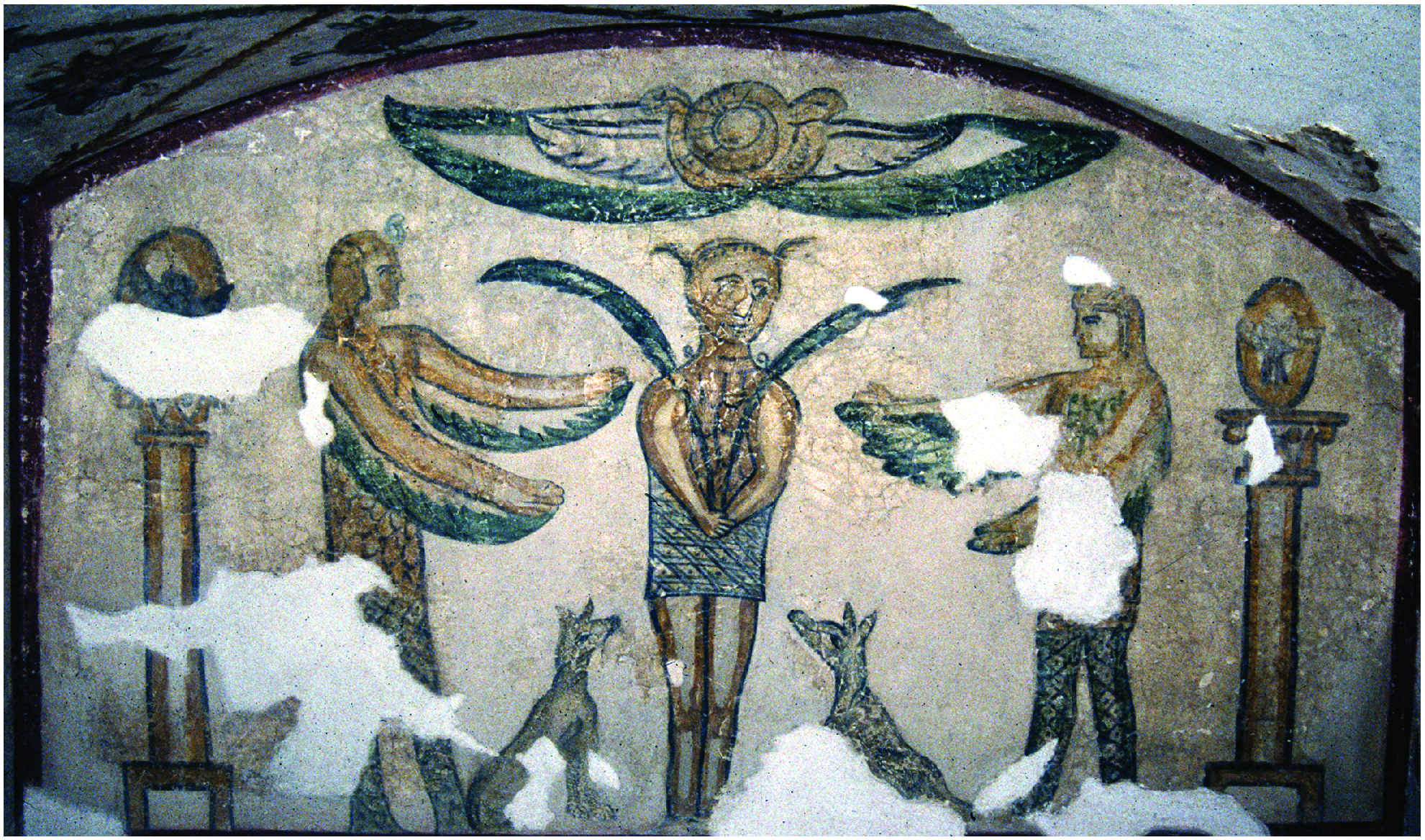
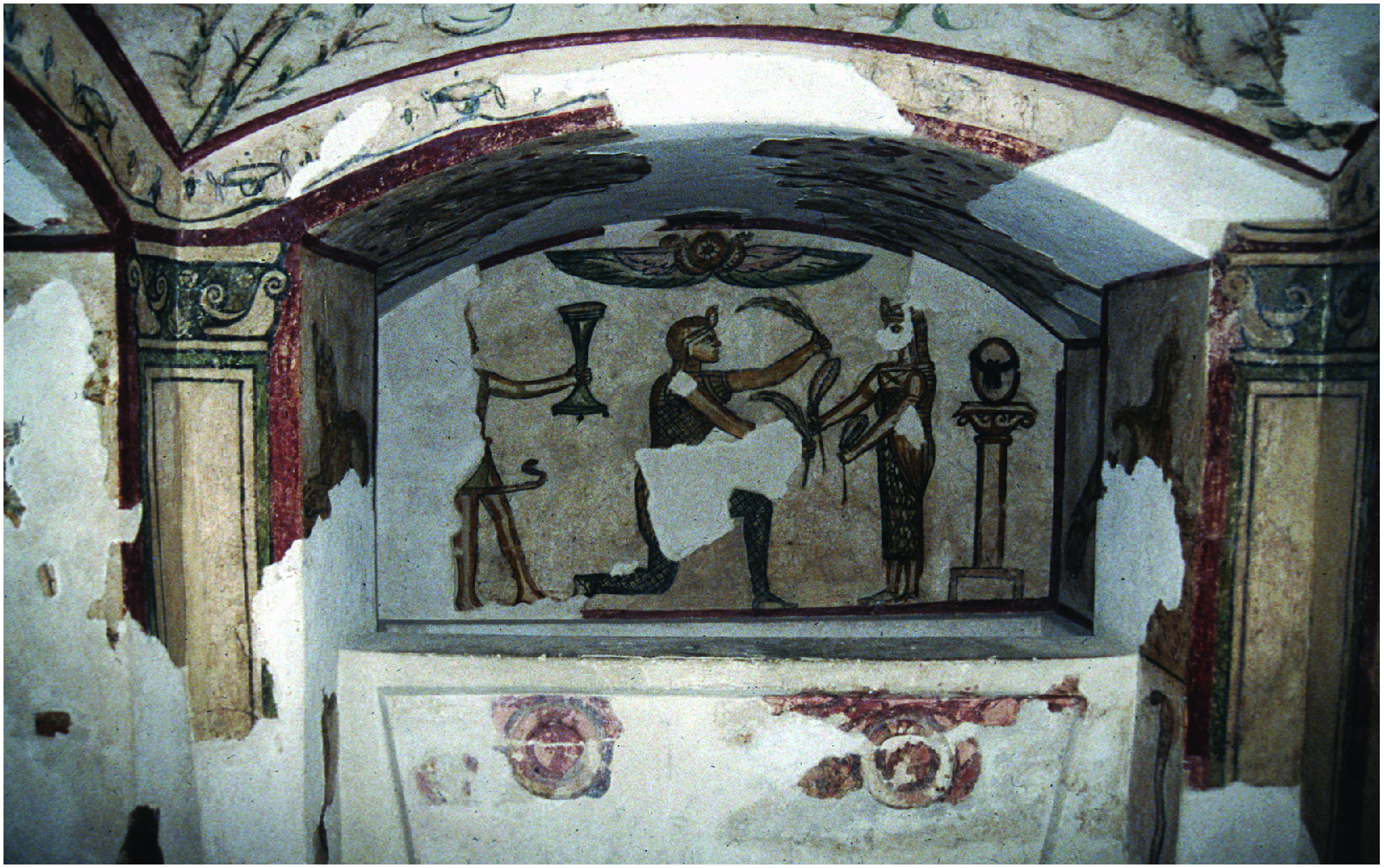



No comments:
Post a Comment